Law and Society Report: Examining Unequal Pay for Women in the UK
VerifiedAdded on 2022/09/12
|7
|1840
|20
Report
AI Summary
This report provides a comprehensive analysis of the issue of unequal pay for women in the UK, framed within the context of Law and Society. It begins by defining discrimination and its impact on women in the workplace, highlighting the historical context of the gender pay gap. The report then explores the relevant legislation, primarily focusing on the Equal Pay Act 1970 and the Equality Act 2010, detailing their provisions and scope. Key aspects of the Equality Act 2010 are discussed, including the concept of 'equality of terms' and the rights of women to equal pay for equal work. The report further examines several case laws, such as City of Edinburgh Council v Wilkinson & Ors and Kenny, v Minister for Justice, Equality and Law Reform, illustrating how the law has been applied in practice. A recent case involving BBC journalist Sarah Montague is also discussed. The report concludes by emphasizing the significance of the Equality Act 2010 in protecting women's rights and preventing workplace discrimination.
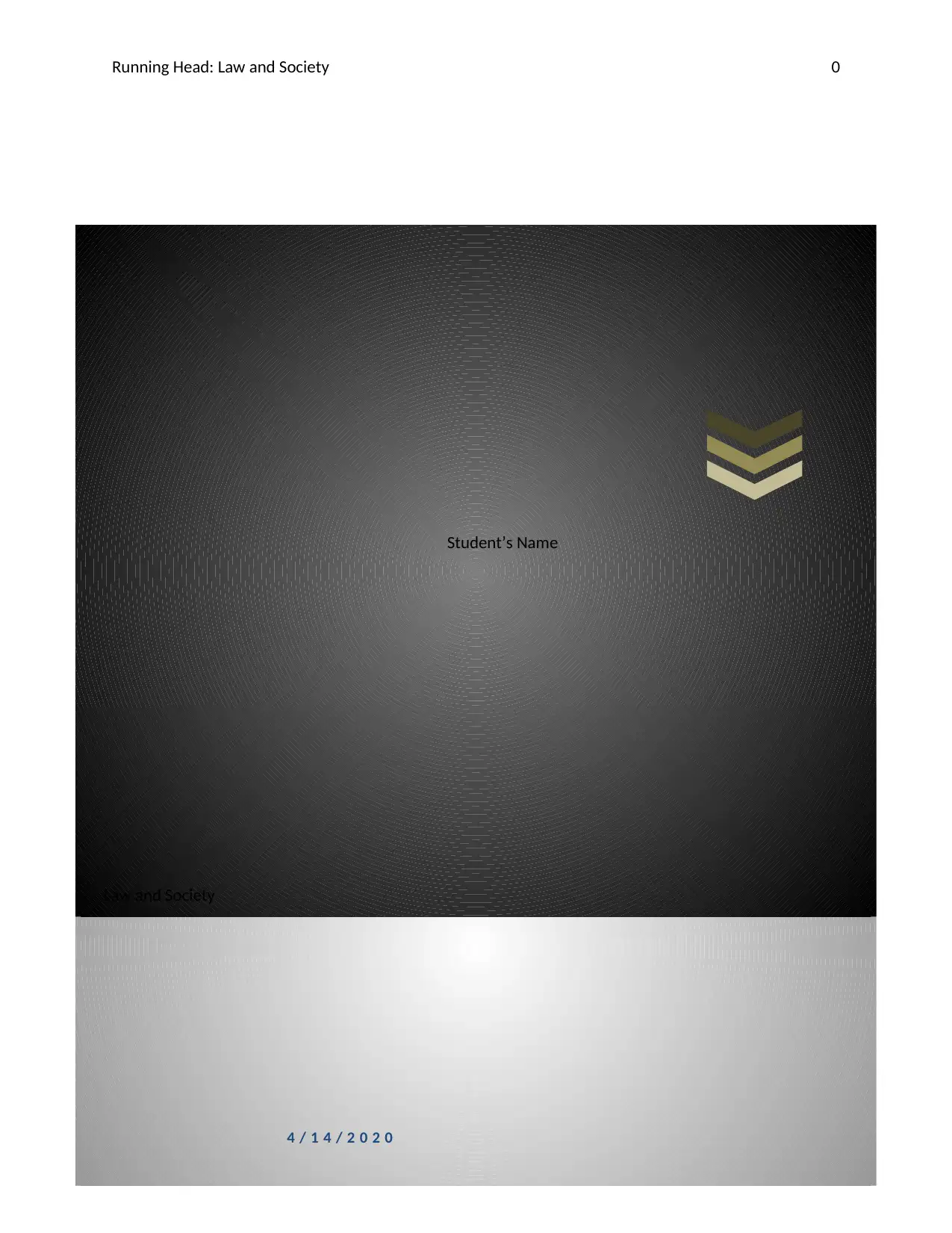
Law and Society
Running Head: Law and Society 0
4 / 1 4 / 2 0 2 0
Student’s Name
Running Head: Law and Society 0
4 / 1 4 / 2 0 2 0
Student’s Name
Paraphrase This Document
Need a fresh take? Get an instant paraphrase of this document with our AI Paraphraser
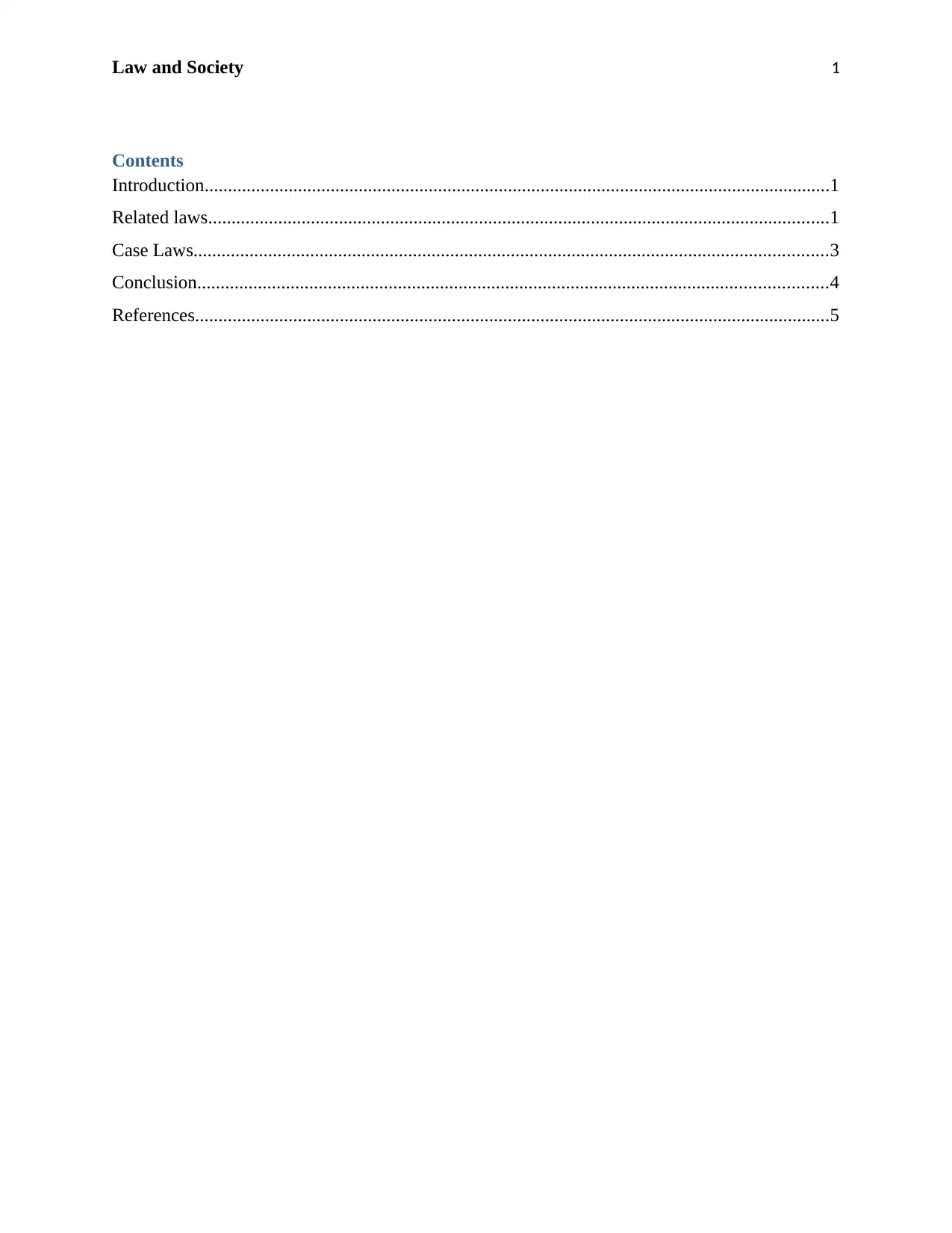
Law and Society 1
Contents
Introduction......................................................................................................................................1
Related laws.....................................................................................................................................1
Case Laws........................................................................................................................................3
Conclusion.......................................................................................................................................4
References........................................................................................................................................5
Contents
Introduction......................................................................................................................................1
Related laws.....................................................................................................................................1
Case Laws........................................................................................................................................3
Conclusion.......................................................................................................................................4
References........................................................................................................................................5
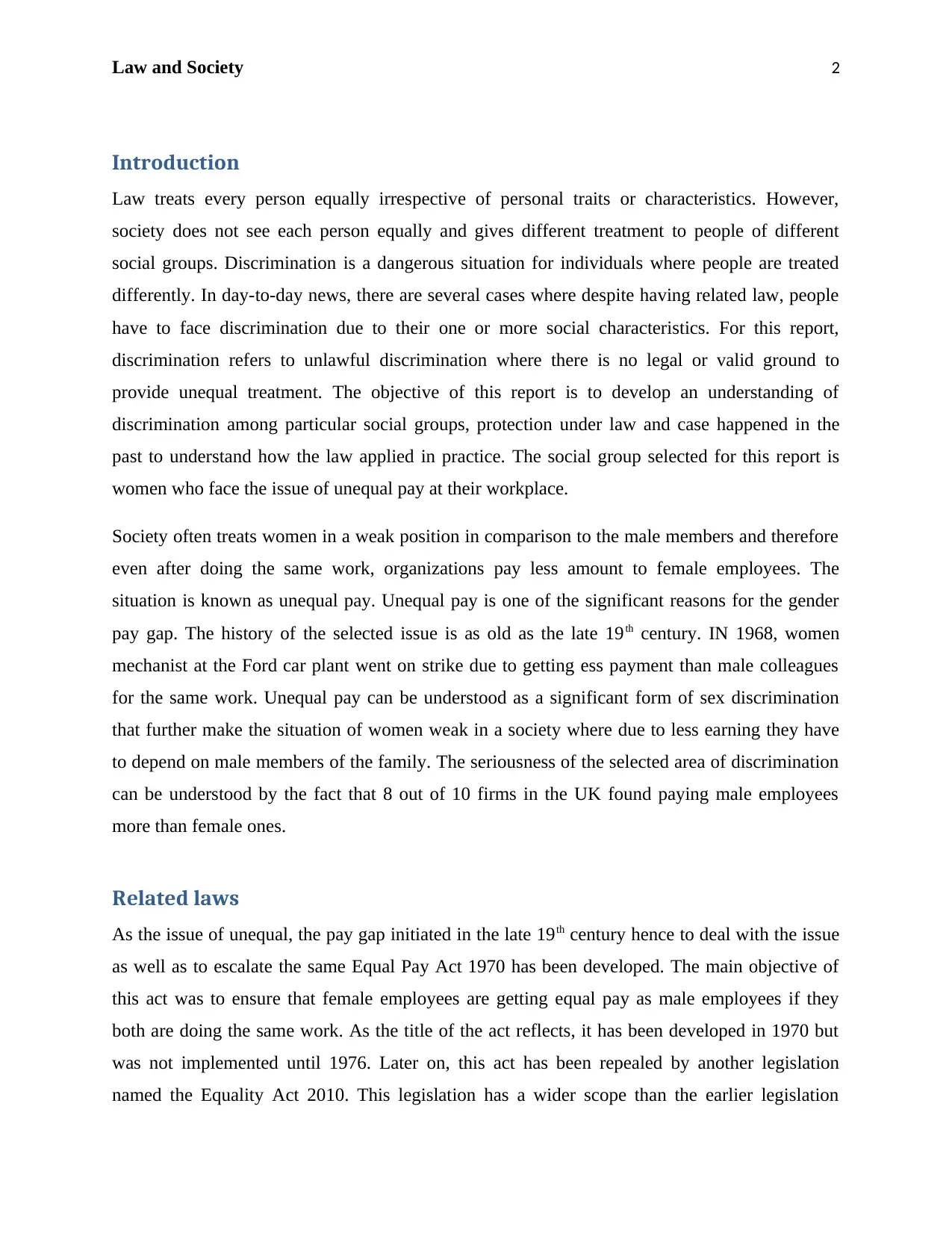
Law and Society 2
Introduction
Law treats every person equally irrespective of personal traits or characteristics. However,
society does not see each person equally and gives different treatment to people of different
social groups. Discrimination is a dangerous situation for individuals where people are treated
differently. In day-to-day news, there are several cases where despite having related law, people
have to face discrimination due to their one or more social characteristics. For this report,
discrimination refers to unlawful discrimination where there is no legal or valid ground to
provide unequal treatment. The objective of this report is to develop an understanding of
discrimination among particular social groups, protection under law and case happened in the
past to understand how the law applied in practice. The social group selected for this report is
women who face the issue of unequal pay at their workplace.
Society often treats women in a weak position in comparison to the male members and therefore
even after doing the same work, organizations pay less amount to female employees. The
situation is known as unequal pay. Unequal pay is one of the significant reasons for the gender
pay gap. The history of the selected issue is as old as the late 19th century. IN 1968, women
mechanist at the Ford car plant went on strike due to getting ess payment than male colleagues
for the same work. Unequal pay can be understood as a significant form of sex discrimination
that further make the situation of women weak in a society where due to less earning they have
to depend on male members of the family. The seriousness of the selected area of discrimination
can be understood by the fact that 8 out of 10 firms in the UK found paying male employees
more than female ones.
Related laws
As the issue of unequal, the pay gap initiated in the late 19th century hence to deal with the issue
as well as to escalate the same Equal Pay Act 1970 has been developed. The main objective of
this act was to ensure that female employees are getting equal pay as male employees if they
both are doing the same work. As the title of the act reflects, it has been developed in 1970 but
was not implemented until 1976. Later on, this act has been repealed by another legislation
named the Equality Act 2010. This legislation has a wider scope than the earlier legislation
Introduction
Law treats every person equally irrespective of personal traits or characteristics. However,
society does not see each person equally and gives different treatment to people of different
social groups. Discrimination is a dangerous situation for individuals where people are treated
differently. In day-to-day news, there are several cases where despite having related law, people
have to face discrimination due to their one or more social characteristics. For this report,
discrimination refers to unlawful discrimination where there is no legal or valid ground to
provide unequal treatment. The objective of this report is to develop an understanding of
discrimination among particular social groups, protection under law and case happened in the
past to understand how the law applied in practice. The social group selected for this report is
women who face the issue of unequal pay at their workplace.
Society often treats women in a weak position in comparison to the male members and therefore
even after doing the same work, organizations pay less amount to female employees. The
situation is known as unequal pay. Unequal pay is one of the significant reasons for the gender
pay gap. The history of the selected issue is as old as the late 19th century. IN 1968, women
mechanist at the Ford car plant went on strike due to getting ess payment than male colleagues
for the same work. Unequal pay can be understood as a significant form of sex discrimination
that further make the situation of women weak in a society where due to less earning they have
to depend on male members of the family. The seriousness of the selected area of discrimination
can be understood by the fact that 8 out of 10 firms in the UK found paying male employees
more than female ones.
Related laws
As the issue of unequal, the pay gap initiated in the late 19th century hence to deal with the issue
as well as to escalate the same Equal Pay Act 1970 has been developed. The main objective of
this act was to ensure that female employees are getting equal pay as male employees if they
both are doing the same work. As the title of the act reflects, it has been developed in 1970 but
was not implemented until 1976. Later on, this act has been repealed by another legislation
named the Equality Act 2010. This legislation has a wider scope than the earlier legislation
⊘ This is a preview!⊘
Do you want full access?
Subscribe today to unlock all pages.

Trusted by 1+ million students worldwide
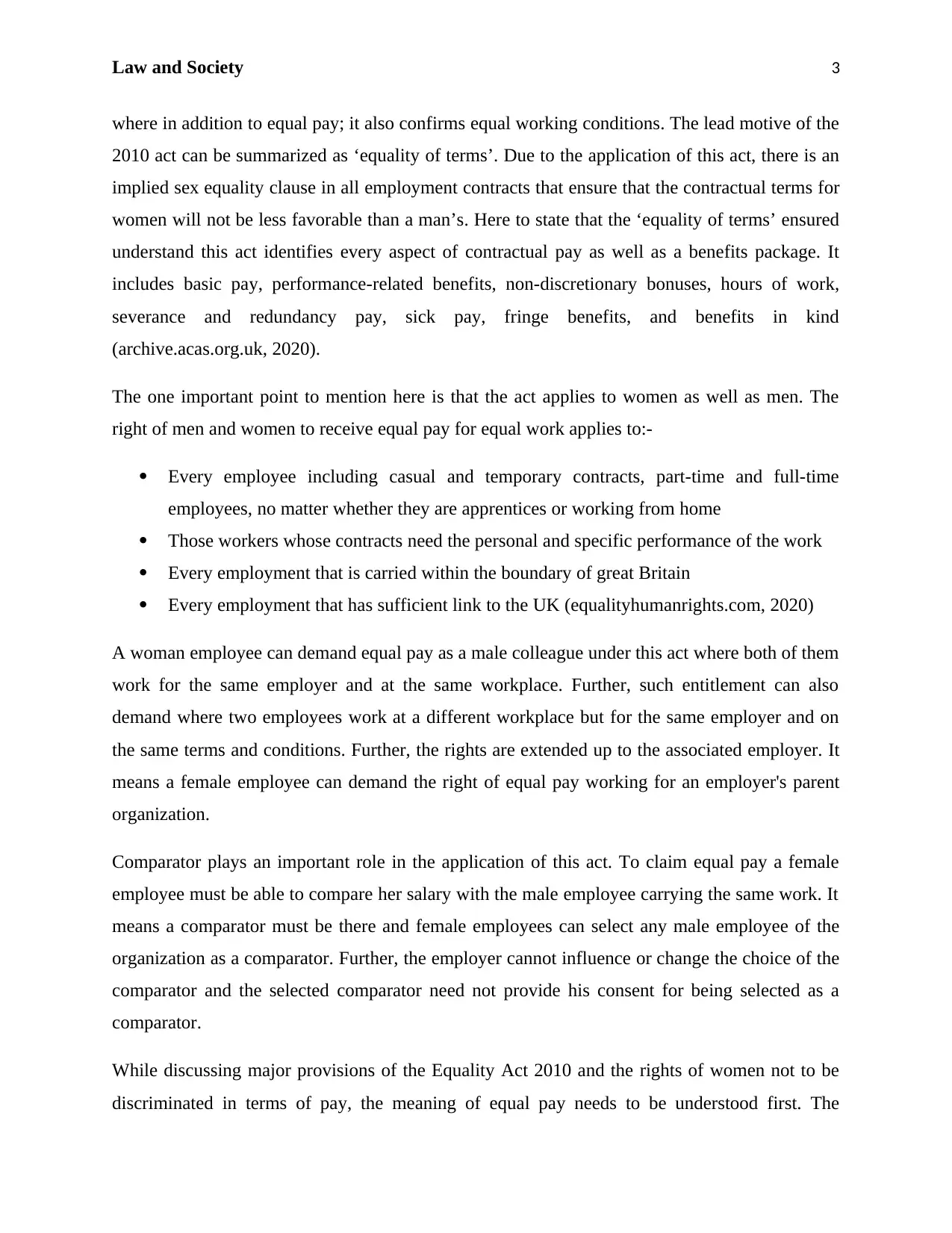
Law and Society 3
where in addition to equal pay; it also confirms equal working conditions. The lead motive of the
2010 act can be summarized as ‘equality of terms’. Due to the application of this act, there is an
implied sex equality clause in all employment contracts that ensure that the contractual terms for
women will not be less favorable than a man’s. Here to state that the ‘equality of terms’ ensured
understand this act identifies every aspect of contractual pay as well as a benefits package. It
includes basic pay, performance-related benefits, non-discretionary bonuses, hours of work,
severance and redundancy pay, sick pay, fringe benefits, and benefits in kind
(archive.acas.org.uk, 2020).
The one important point to mention here is that the act applies to women as well as men. The
right of men and women to receive equal pay for equal work applies to:-
Every employee including casual and temporary contracts, part-time and full-time
employees, no matter whether they are apprentices or working from home
Those workers whose contracts need the personal and specific performance of the work
Every employment that is carried within the boundary of great Britain
Every employment that has sufficient link to the UK (equalityhumanrights.com, 2020)
A woman employee can demand equal pay as a male colleague under this act where both of them
work for the same employer and at the same workplace. Further, such entitlement can also
demand where two employees work at a different workplace but for the same employer and on
the same terms and conditions. Further, the rights are extended up to the associated employer. It
means a female employee can demand the right of equal pay working for an employer's parent
organization.
Comparator plays an important role in the application of this act. To claim equal pay a female
employee must be able to compare her salary with the male employee carrying the same work. It
means a comparator must be there and female employees can select any male employee of the
organization as a comparator. Further, the employer cannot influence or change the choice of the
comparator and the selected comparator need not provide his consent for being selected as a
comparator.
While discussing major provisions of the Equality Act 2010 and the rights of women not to be
discriminated in terms of pay, the meaning of equal pay needs to be understood first. The
where in addition to equal pay; it also confirms equal working conditions. The lead motive of the
2010 act can be summarized as ‘equality of terms’. Due to the application of this act, there is an
implied sex equality clause in all employment contracts that ensure that the contractual terms for
women will not be less favorable than a man’s. Here to state that the ‘equality of terms’ ensured
understand this act identifies every aspect of contractual pay as well as a benefits package. It
includes basic pay, performance-related benefits, non-discretionary bonuses, hours of work,
severance and redundancy pay, sick pay, fringe benefits, and benefits in kind
(archive.acas.org.uk, 2020).
The one important point to mention here is that the act applies to women as well as men. The
right of men and women to receive equal pay for equal work applies to:-
Every employee including casual and temporary contracts, part-time and full-time
employees, no matter whether they are apprentices or working from home
Those workers whose contracts need the personal and specific performance of the work
Every employment that is carried within the boundary of great Britain
Every employment that has sufficient link to the UK (equalityhumanrights.com, 2020)
A woman employee can demand equal pay as a male colleague under this act where both of them
work for the same employer and at the same workplace. Further, such entitlement can also
demand where two employees work at a different workplace but for the same employer and on
the same terms and conditions. Further, the rights are extended up to the associated employer. It
means a female employee can demand the right of equal pay working for an employer's parent
organization.
Comparator plays an important role in the application of this act. To claim equal pay a female
employee must be able to compare her salary with the male employee carrying the same work. It
means a comparator must be there and female employees can select any male employee of the
organization as a comparator. Further, the employer cannot influence or change the choice of the
comparator and the selected comparator need not provide his consent for being selected as a
comparator.
While discussing major provisions of the Equality Act 2010 and the rights of women not to be
discriminated in terms of pay, the meaning of equal pay needs to be understood first. The
Paraphrase This Document
Need a fresh take? Get an instant paraphrase of this document with our AI Paraphraser
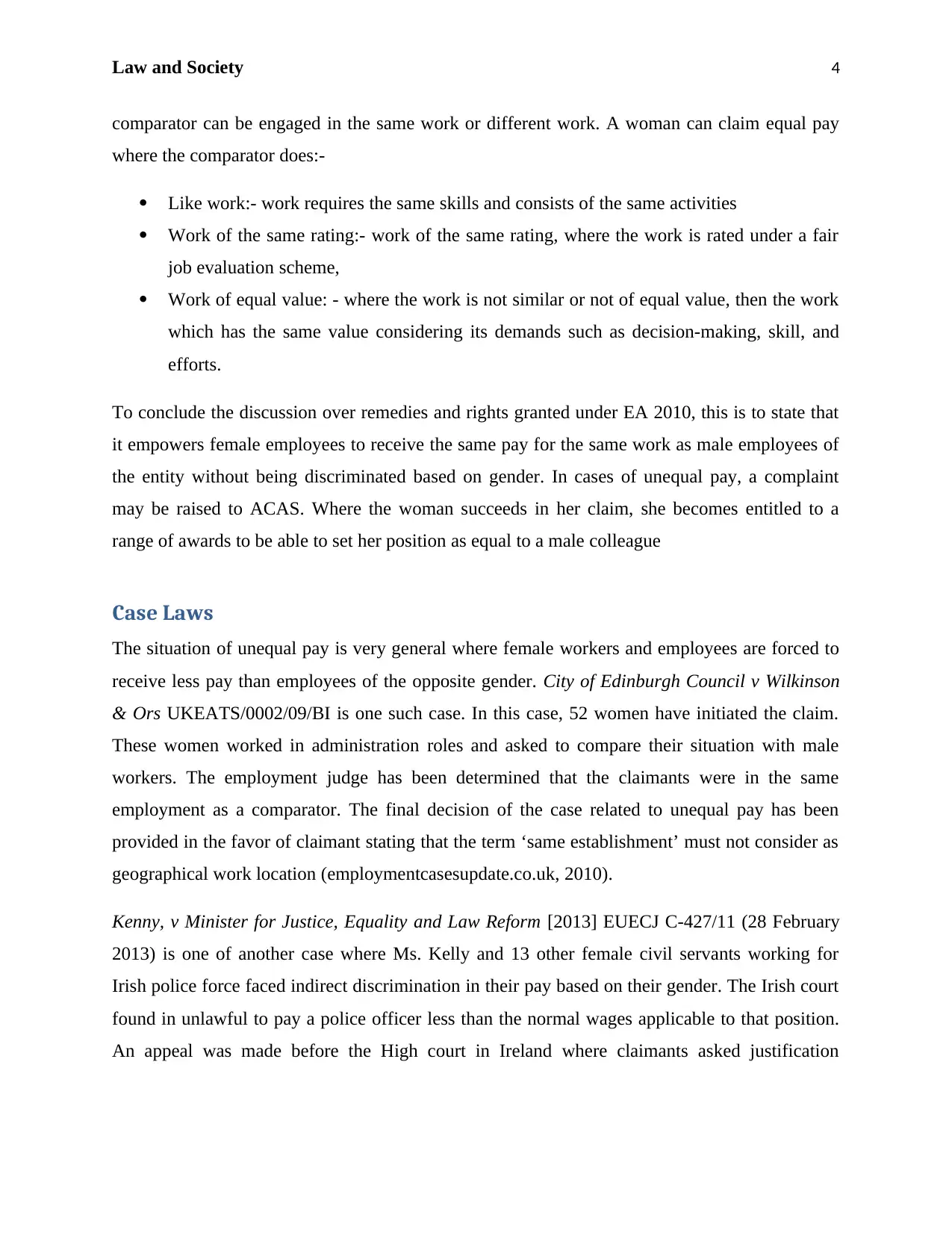
Law and Society 4
comparator can be engaged in the same work or different work. A woman can claim equal pay
where the comparator does:-
Like work:- work requires the same skills and consists of the same activities
Work of the same rating:- work of the same rating, where the work is rated under a fair
job evaluation scheme,
Work of equal value: - where the work is not similar or not of equal value, then the work
which has the same value considering its demands such as decision-making, skill, and
efforts.
To conclude the discussion over remedies and rights granted under EA 2010, this is to state that
it empowers female employees to receive the same pay for the same work as male employees of
the entity without being discriminated based on gender. In cases of unequal pay, a complaint
may be raised to ACAS. Where the woman succeeds in her claim, she becomes entitled to a
range of awards to be able to set her position as equal to a male colleague
Case Laws
The situation of unequal pay is very general where female workers and employees are forced to
receive less pay than employees of the opposite gender. City of Edinburgh Council v Wilkinson
& Ors UKEATS/0002/09/BI is one such case. In this case, 52 women have initiated the claim.
These women worked in administration roles and asked to compare their situation with male
workers. The employment judge has been determined that the claimants were in the same
employment as a comparator. The final decision of the case related to unequal pay has been
provided in the favor of claimant stating that the term ‘same establishment’ must not consider as
geographical work location (employmentcasesupdate.co.uk, 2010).
Kenny, v Minister for Justice, Equality and Law Reform [2013] EUECJ C-427/11 (28 February
2013) is one of another case where Ms. Kelly and 13 other female civil servants working for
Irish police force faced indirect discrimination in their pay based on their gender. The Irish court
found in unlawful to pay a police officer less than the normal wages applicable to that position.
An appeal was made before the High court in Ireland where claimants asked justification
comparator can be engaged in the same work or different work. A woman can claim equal pay
where the comparator does:-
Like work:- work requires the same skills and consists of the same activities
Work of the same rating:- work of the same rating, where the work is rated under a fair
job evaluation scheme,
Work of equal value: - where the work is not similar or not of equal value, then the work
which has the same value considering its demands such as decision-making, skill, and
efforts.
To conclude the discussion over remedies and rights granted under EA 2010, this is to state that
it empowers female employees to receive the same pay for the same work as male employees of
the entity without being discriminated based on gender. In cases of unequal pay, a complaint
may be raised to ACAS. Where the woman succeeds in her claim, she becomes entitled to a
range of awards to be able to set her position as equal to a male colleague
Case Laws
The situation of unequal pay is very general where female workers and employees are forced to
receive less pay than employees of the opposite gender. City of Edinburgh Council v Wilkinson
& Ors UKEATS/0002/09/BI is one such case. In this case, 52 women have initiated the claim.
These women worked in administration roles and asked to compare their situation with male
workers. The employment judge has been determined that the claimants were in the same
employment as a comparator. The final decision of the case related to unequal pay has been
provided in the favor of claimant stating that the term ‘same establishment’ must not consider as
geographical work location (employmentcasesupdate.co.uk, 2010).
Kenny, v Minister for Justice, Equality and Law Reform [2013] EUECJ C-427/11 (28 February
2013) is one of another case where Ms. Kelly and 13 other female civil servants working for
Irish police force faced indirect discrimination in their pay based on their gender. The Irish court
found in unlawful to pay a police officer less than the normal wages applicable to that position.
An appeal was made before the High court in Ireland where claimants asked justification
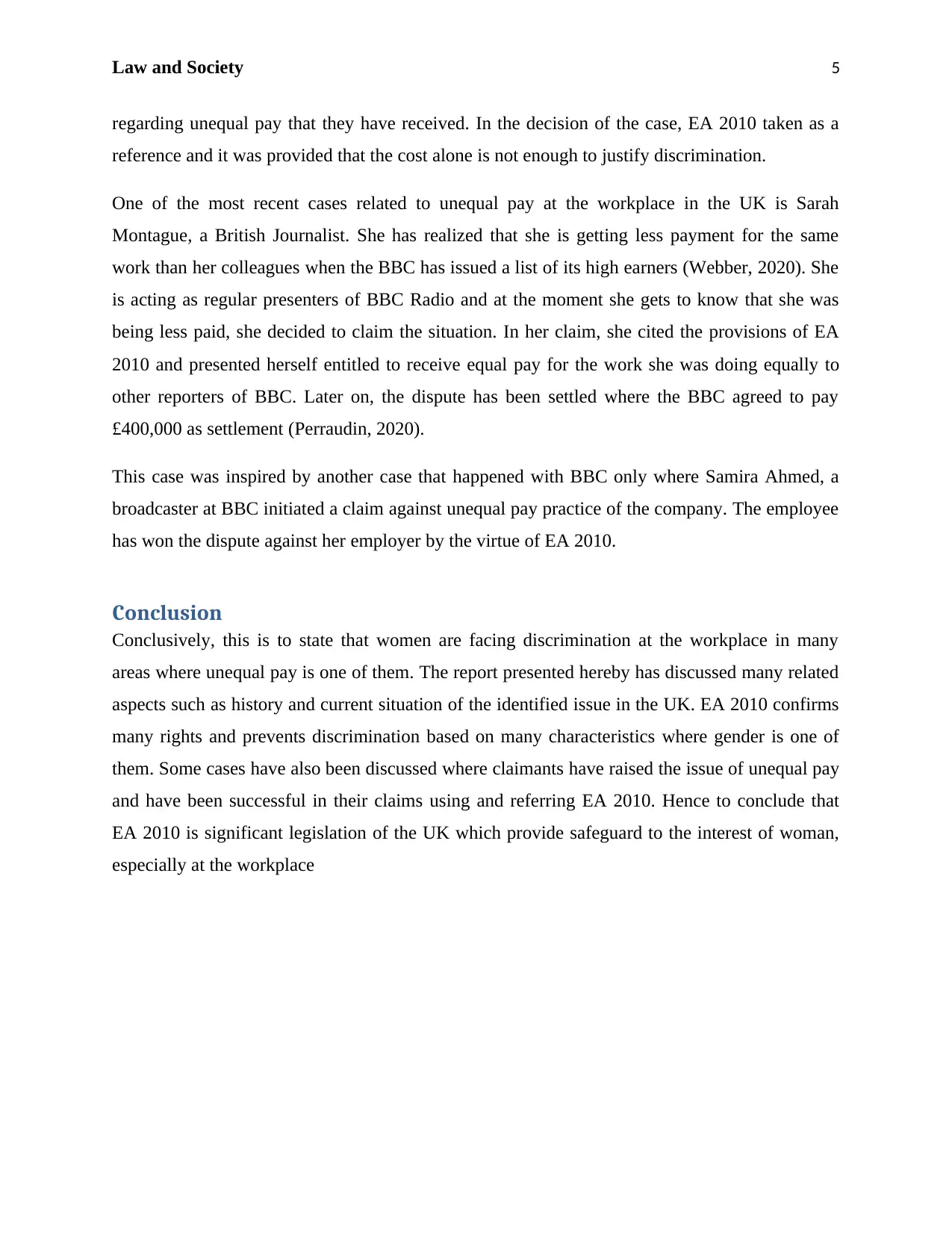
Law and Society 5
regarding unequal pay that they have received. In the decision of the case, EA 2010 taken as a
reference and it was provided that the cost alone is not enough to justify discrimination.
One of the most recent cases related to unequal pay at the workplace in the UK is Sarah
Montague, a British Journalist. She has realized that she is getting less payment for the same
work than her colleagues when the BBC has issued a list of its high earners (Webber, 2020). She
is acting as regular presenters of BBC Radio and at the moment she gets to know that she was
being less paid, she decided to claim the situation. In her claim, she cited the provisions of EA
2010 and presented herself entitled to receive equal pay for the work she was doing equally to
other reporters of BBC. Later on, the dispute has been settled where the BBC agreed to pay
£400,000 as settlement (Perraudin, 2020).
This case was inspired by another case that happened with BBC only where Samira Ahmed, a
broadcaster at BBC initiated a claim against unequal pay practice of the company. The employee
has won the dispute against her employer by the virtue of EA 2010.
Conclusion
Conclusively, this is to state that women are facing discrimination at the workplace in many
areas where unequal pay is one of them. The report presented hereby has discussed many related
aspects such as history and current situation of the identified issue in the UK. EA 2010 confirms
many rights and prevents discrimination based on many characteristics where gender is one of
them. Some cases have also been discussed where claimants have raised the issue of unequal pay
and have been successful in their claims using and referring EA 2010. Hence to conclude that
EA 2010 is significant legislation of the UK which provide safeguard to the interest of woman,
especially at the workplace
regarding unequal pay that they have received. In the decision of the case, EA 2010 taken as a
reference and it was provided that the cost alone is not enough to justify discrimination.
One of the most recent cases related to unequal pay at the workplace in the UK is Sarah
Montague, a British Journalist. She has realized that she is getting less payment for the same
work than her colleagues when the BBC has issued a list of its high earners (Webber, 2020). She
is acting as regular presenters of BBC Radio and at the moment she gets to know that she was
being less paid, she decided to claim the situation. In her claim, she cited the provisions of EA
2010 and presented herself entitled to receive equal pay for the work she was doing equally to
other reporters of BBC. Later on, the dispute has been settled where the BBC agreed to pay
£400,000 as settlement (Perraudin, 2020).
This case was inspired by another case that happened with BBC only where Samira Ahmed, a
broadcaster at BBC initiated a claim against unequal pay practice of the company. The employee
has won the dispute against her employer by the virtue of EA 2010.
Conclusion
Conclusively, this is to state that women are facing discrimination at the workplace in many
areas where unequal pay is one of them. The report presented hereby has discussed many related
aspects such as history and current situation of the identified issue in the UK. EA 2010 confirms
many rights and prevents discrimination based on many characteristics where gender is one of
them. Some cases have also been discussed where claimants have raised the issue of unequal pay
and have been successful in their claims using and referring EA 2010. Hence to conclude that
EA 2010 is significant legislation of the UK which provide safeguard to the interest of woman,
especially at the workplace
⊘ This is a preview!⊘
Do you want full access?
Subscribe today to unlock all pages.

Trusted by 1+ million students worldwide
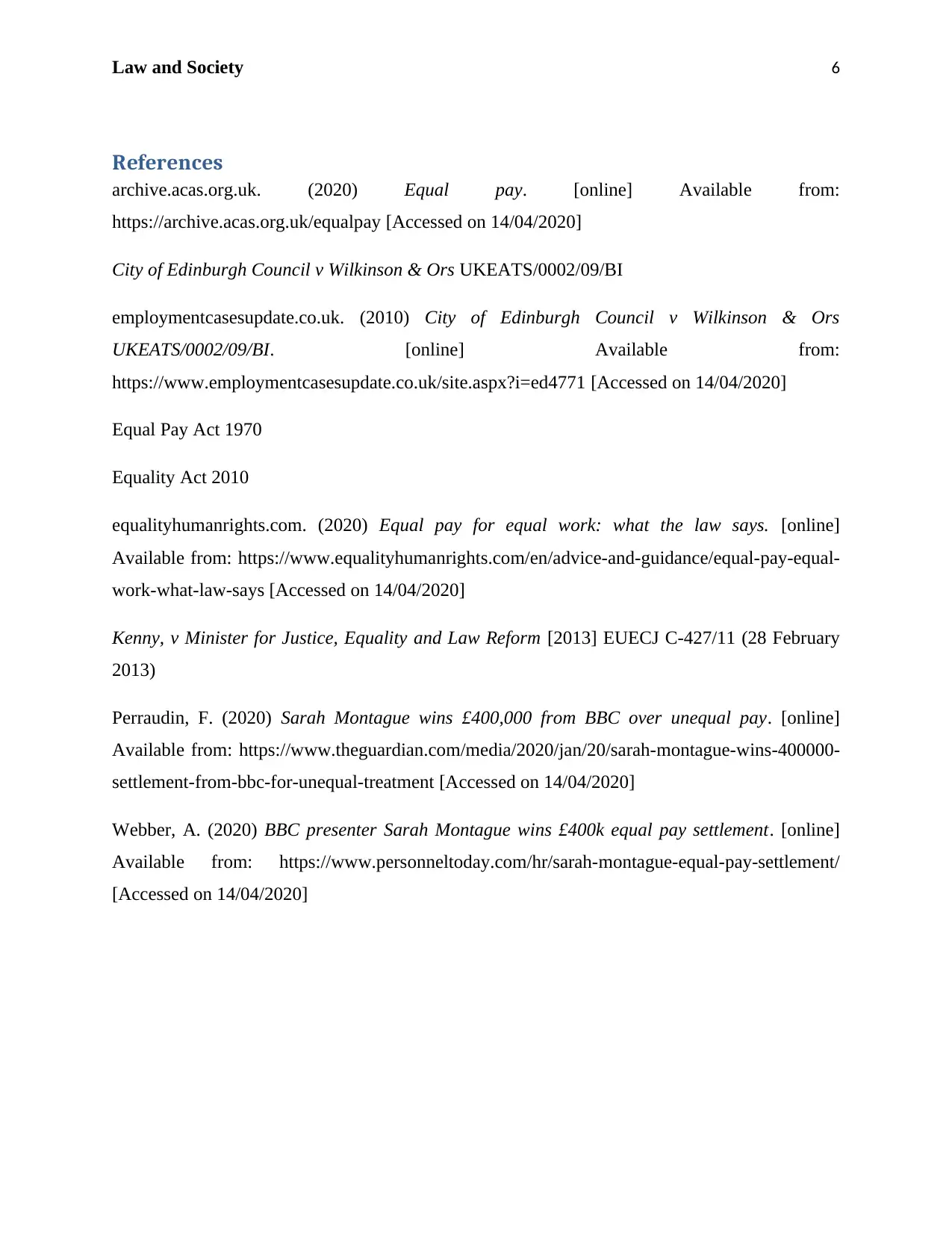
Law and Society 6
References
archive.acas.org.uk. (2020) Equal pay. [online] Available from:
https://archive.acas.org.uk/equalpay [Accessed on 14/04/2020]
City of Edinburgh Council v Wilkinson & Ors UKEATS/0002/09/BI
employmentcasesupdate.co.uk. (2010) City of Edinburgh Council v Wilkinson & Ors
UKEATS/0002/09/BI. [online] Available from:
https://www.employmentcasesupdate.co.uk/site.aspx?i=ed4771 [Accessed on 14/04/2020]
Equal Pay Act 1970
Equality Act 2010
equalityhumanrights.com. (2020) Equal pay for equal work: what the law says. [online]
Available from: https://www.equalityhumanrights.com/en/advice-and-guidance/equal-pay-equal-
work-what-law-says [Accessed on 14/04/2020]
Kenny, v Minister for Justice, Equality and Law Reform [2013] EUECJ C-427/11 (28 February
2013)
Perraudin, F. (2020) Sarah Montague wins £400,000 from BBC over unequal pay. [online]
Available from: https://www.theguardian.com/media/2020/jan/20/sarah-montague-wins-400000-
settlement-from-bbc-for-unequal-treatment [Accessed on 14/04/2020]
Webber, A. (2020) BBC presenter Sarah Montague wins £400k equal pay settlement. [online]
Available from: https://www.personneltoday.com/hr/sarah-montague-equal-pay-settlement/
[Accessed on 14/04/2020]
References
archive.acas.org.uk. (2020) Equal pay. [online] Available from:
https://archive.acas.org.uk/equalpay [Accessed on 14/04/2020]
City of Edinburgh Council v Wilkinson & Ors UKEATS/0002/09/BI
employmentcasesupdate.co.uk. (2010) City of Edinburgh Council v Wilkinson & Ors
UKEATS/0002/09/BI. [online] Available from:
https://www.employmentcasesupdate.co.uk/site.aspx?i=ed4771 [Accessed on 14/04/2020]
Equal Pay Act 1970
Equality Act 2010
equalityhumanrights.com. (2020) Equal pay for equal work: what the law says. [online]
Available from: https://www.equalityhumanrights.com/en/advice-and-guidance/equal-pay-equal-
work-what-law-says [Accessed on 14/04/2020]
Kenny, v Minister for Justice, Equality and Law Reform [2013] EUECJ C-427/11 (28 February
2013)
Perraudin, F. (2020) Sarah Montague wins £400,000 from BBC over unequal pay. [online]
Available from: https://www.theguardian.com/media/2020/jan/20/sarah-montague-wins-400000-
settlement-from-bbc-for-unequal-treatment [Accessed on 14/04/2020]
Webber, A. (2020) BBC presenter Sarah Montague wins £400k equal pay settlement. [online]
Available from: https://www.personneltoday.com/hr/sarah-montague-equal-pay-settlement/
[Accessed on 14/04/2020]
1 out of 7
Related Documents
Your All-in-One AI-Powered Toolkit for Academic Success.
+13062052269
info@desklib.com
Available 24*7 on WhatsApp / Email
![[object Object]](/_next/static/media/star-bottom.7253800d.svg)
Unlock your academic potential
Copyright © 2020–2025 A2Z Services. All Rights Reserved. Developed and managed by ZUCOL.





